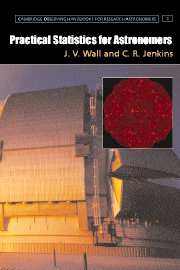Book contents
- Frontmatter
- Contents
- Preface
- Note on notation
- 1 Decision
- 2 Probability
- 3 Statistics and expectations
- 4 Correlation and association
- 5 Hypothesis testing
- 6 Data modelling; parameter estimation
- 7 Detection and surveys
- 8 Sequential data – 1D statistics
- 9 Surface distribution – 2D statistics
- Appendix 1 The literature
- Appendix 2 Statistical tables
- References
- Index
9 - Surface distribution – 2D statistics
Published online by Cambridge University Press: 02 September 2009
- Frontmatter
- Contents
- Preface
- Note on notation
- 1 Decision
- 2 Probability
- 3 Statistics and expectations
- 4 Correlation and association
- 5 Hypothesis testing
- 6 Data modelling; parameter estimation
- 7 Detection and surveys
- 8 Sequential data – 1D statistics
- 9 Surface distribution – 2D statistics
- Appendix 1 The literature
- Appendix 2 Statistical tables
- References
- Index
Summary
An examination of the distribution of the numbers of galaxies recorded on photographic plates shows that it does not conform to the Poisson law and indicates the presence of a factor causing ‘contagion’.
(Neyman, Scott & Shane 1953)The distribution of objects on the celestial sphere, or on an imaged patch of this sphere, has ever been a major preoccupation of astronomers. Avoiding here the science of image processing, the province of thousands of books and papers, we consider some of the common statistical approaches used to quantify sky distributions in order to permit contact with theory. Before we turn to the adopted statistical weaponry of galaxy distribution, we discuss some general statistics applicable to the spherical surface.
Statistics on a spherical surface
Abstractly, the distribution of objects on the celestial sphere is simply the distribution of directions of a set of unit vectors. In this respect, other three-dimensional spaces may be of interest, like the Poincaré sphere with unit vectors indicating the state of polarization of radiation.
This is a thriving subfield of statistics and there is an excellent hand-book (Fisher, Lewis & Embleton 1987). Much of the motivation comes from geophysical topics (orientation of palaeomagnetism, for instance) but many other ‘spaces’ are of interest. The emphasis is on statistical modelling and a variety of distributions is available. The Fisher distribution, one of the most popular, plays a similar role in spherical statistics to that played by the Gaussian in ordinary statistics.
- Type
- Chapter
- Information
- Practical Statistics for Astronomers , pp. 214 - 245Publisher: Cambridge University PressPrint publication year: 2003



